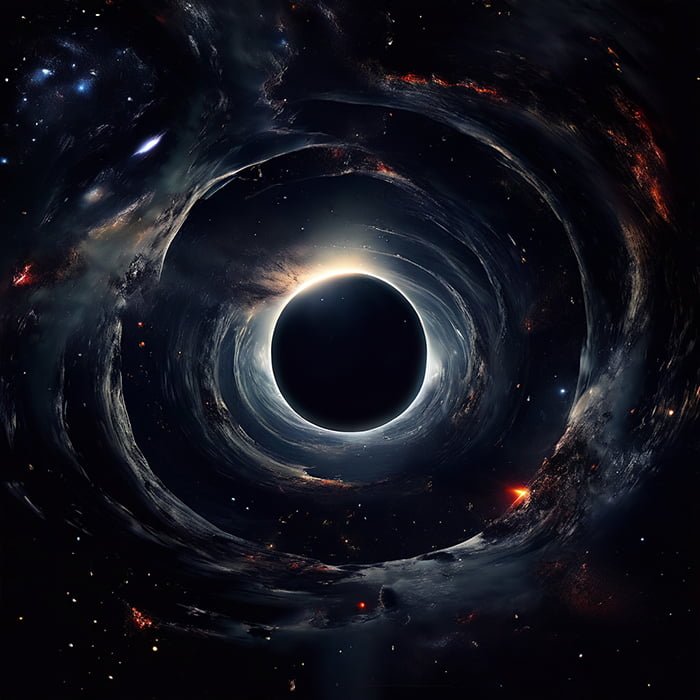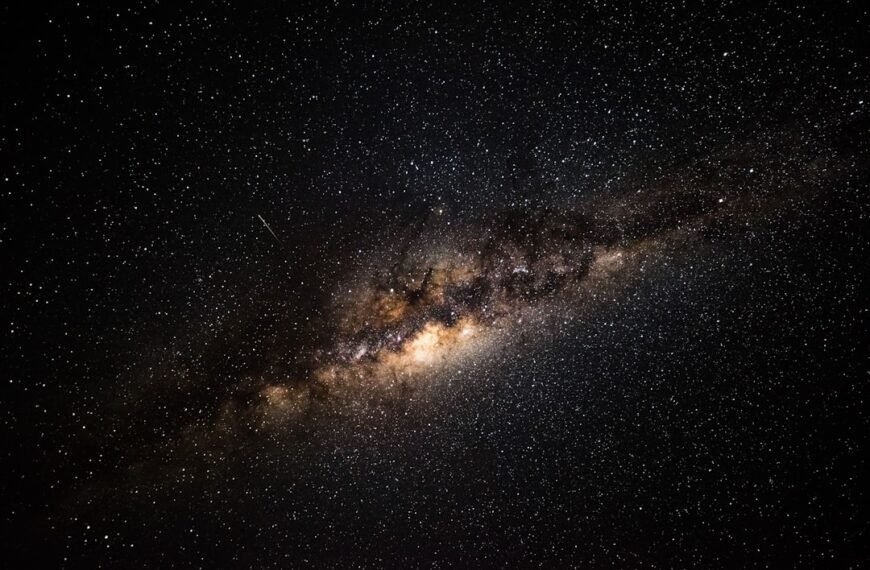Black holes are one of the most fascinating and mysterious objects in the universe. They are regions in space where gravity is so strong that nothing, not even light, can escape their gravitational pull. The concept of black holes was first proposed by physicist John Michell in 1783, but it wasn’t until the early 20th century that scientists began to seriously study and understand them.
The study of black holes has played a crucial role in the field of astrophysics. They have provided insights into the nature of gravity, the behavior of matter under extreme conditions, and the evolution of galaxies. Black holes have also been a subject of fascination for the general public, appearing in popular culture and inspiring countless works of science fiction.
Key Takeaways
- Black holes are regions in space where gravity is so strong that nothing, not even light, can escape.
- Scientists search for black holes by observing their effects on nearby matter and radiation.
- There are three types of black holes: stellar, intermediate, and supermassive.
- Our Milky Way galaxy contains a supermassive black hole at its center.
- Supermassive black holes in other galaxies play a crucial role in the evolution of their host galaxies.
The Search for Black Holes
Detecting black holes is no easy task. Since they do not emit any light or radiation, they cannot be observed directly. Instead, scientists rely on indirect methods to search for black holes. One such method is observing the effects of a black hole’s gravitational pull on nearby objects. For example, if a black hole is in a binary system with a companion star, it can cause the star to orbit around it in a characteristic way.
Another method used to search for black holes is through the detection of X-rays emitted by hot gas falling into a black hole. As the gas spirals towards the black hole, it heats up and emits X-rays that can be detected by telescopes. This method has been particularly successful in identifying stellar-mass black holes.
However, detecting black holes is not without its challenges. For one, they are incredibly small compared to their mass, making them difficult to observe directly. Additionally, black holes are often surrounded by dense clouds of gas and dust, which can obscure our view of them. Despite these challenges, breakthrough discoveries have been made in recent years that have greatly advanced our understanding of black holes.
Types of Black Holes
There are several different types of black holes, each with its own unique characteristics. The most common type is the stellar black hole, which forms when a massive star collapses under its own gravity. Stellar black holes have masses ranging from a few times that of the Sun to several tens of times that of the Sun.
Another type of black hole is the intermediate black hole, which has a mass between that of a stellar black hole and a supermassive black hole. Intermediate black holes are thought to form through the merger of smaller black holes or through the collapse of massive star clusters.
Supermassive black holes are the largest type of black holes, with masses ranging from millions to billions of times that of the Sun. They are found at the centers of most galaxies, including our own Milky Way. The origin of supermassive black holes is still not well understood, but they are thought to play a crucial role in the evolution of galaxies.
Finally, there is the hypothetical primordial black hole, which is believed to have formed in the early universe shortly after the Big Bang. Primordial black holes would have very small masses and could potentially make up a significant fraction of dark matter in the universe.
Black Holes in Our Milky Way Galaxy
There is strong evidence for the existence of several black holes in our own Milky Way galaxy. One of the most well-known is Sagittarius A*, which is located at the center of our galaxy. Sagittarius A* is a supermassive black hole with a mass of about four million times that of the Sun.
The presence of Sagittarius A* was first inferred from the motion of stars near the galactic center. These stars were observed to be orbiting around an invisible object with a mass much larger than any known star. Subsequent observations using radio and infrared telescopes have provided further evidence for the existence of Sagittarius A*.
The discovery of black holes in our galaxy has important implications for our understanding of the universe. It suggests that black holes are a common outcome of stellar evolution and that they play a crucial role in shaping the structure and dynamics of galaxies.
Supermassive Black Holes in Other Galaxies
Supermassive black holes are not unique to our Milky Way galaxy. They have been observed in many other galaxies as well, including distant galaxies that existed when the universe was much younger. The discovery of supermassive black holes in other galaxies has provided valuable insights into their formation and evolution.
One of the most intriguing findings is the relationship between supermassive black holes and galaxy evolution. It is now believed that supermassive black holes form through the accretion of gas and the merger of smaller black holes. As a supermassive black hole grows, it releases a tremendous amount of energy in the form of radiation and jets of high-energy particles. This energy can have a profound impact on the surrounding galaxy, regulating star formation and influencing its overall structure.
The role of supermassive black holes in the universe is still not fully understood, but it is clear that they play a crucial role in shaping the cosmos. They are thought to be responsible for the formation of quasars, which are among the most luminous objects in the universe. Supermassive black holes also produce gravitational waves, which were first detected in 2015 and have opened up a new window into the study of the universe.
The Role of Black Holes in the Universe

Black holes are not just fascinating objects to study; they also play a fundamental role in the workings of the universe. One way in which black holes contribute to the cosmic landscape is as cosmic engines. When matter falls into a black hole, it releases a tremendous amount of energy, which can power some of the most energetic phenomena in the universe, such as quasars and gamma-ray bursts.
Black holes are also sources of gravitational waves, which are ripples in the fabric of spacetime. Gravitational waves were first predicted by Albert Einstein in his theory of general relativity, but it wasn’t until 2015 that they were directly detected for the first time. Since then, several more detections have been made, all of which have involved black holes.
Gravitational waves provide a unique way to study black holes and other astrophysical phenomena. They allow scientists to probe the nature of gravity and test the predictions of general relativity in extreme conditions. Gravitational wave astronomy is still in its infancy, but it holds great promise for uncovering new insights into the universe.
The Formation and Evolution of Black Holes
The formation of black holes is a complex process that depends on the mass and composition of the collapsing object. In the case of stellar black holes, they form when a massive star runs out of nuclear fuel and collapses under its own gravity. The core of the star collapses to a point of infinite density known as a singularity, surrounded by an event horizon from which nothing can escape.
The life cycle of a black hole is also fascinating. Initially, a black hole grows by accreting matter from its surroundings. As matter falls into the black hole, it forms an accretion disk that emits radiation across the electromagnetic spectrum. This process can last for millions or even billions of years, depending on the availability of nearby matter.
Eventually, a black hole can stop growing if it runs out of nearby matter to accrete. At this point, it enters a phase known as “evaporation” or “Hawking radiation,” named after physicist Stephen Hawking who first proposed its existence. According to Hawking’s theory, black holes slowly lose mass over time due to quantum effects near the event horizon. Eventually, a black hole will evaporate completely, leaving behind only a burst of radiation.
The Detection and Study of Black Holes
The study of black holes relies on a combination of observational techniques and theoretical models. Observationally, scientists use a variety of telescopes and instruments to detect the effects of black holes on their surroundings. This includes observing the motion of stars and gas near a black hole, as well as detecting the radiation emitted by matter falling into a black hole.
Theoretical models are used to interpret the observational data and make predictions about the behavior of black holes. These models are based on the laws of physics, particularly general relativity, which describes the behavior of gravity in extreme conditions. Supercomputer simulations are also used to simulate the formation and evolution of black holes and test theoretical predictions.
The study of black holes is a collaborative effort involving scientists from around the world. International collaborations such as the Event Horizon Telescope have brought together researchers from different disciplines to study black holes. These collaborations have been instrumental in making breakthrough discoveries and advancing our understanding of these enigmatic objects.
The Future of Black Hole Research
The future of black hole research looks promising, with several upcoming missions and projects that will further our understanding of these mysterious objects. One such mission is the European Space Agency’s LISA (Laser Interferometer Space Antenna) mission, which is set to launch in the 2030s. LISA will be the first space-based gravitational wave observatory and will allow scientists to detect gravitational waves from a wider range of sources, including supermassive black hole mergers.
Advancements in technology and techniques are also expected to revolutionize black hole research. For example, improvements in telescope technology will allow us to observe black holes with even greater precision and sensitivity. New theoretical models and simulations will also help refine our understanding of black hole formation and evolution.
There is also the potential for new breakthroughs in our understanding of black holes. For example, the discovery of primordial black holes could provide valuable insights into the early universe and the nature of dark matter. The detection of gravitational waves from black hole mergers could also shed light on the behavior of matter under extreme conditions.
The Mysteries of Black Holes
In conclusion, black holes are some of the most intriguing and mysterious objects in the universe. They have captivated the imagination of scientists and the general public alike, and their study has revolutionized our understanding of the cosmos. From their formation and evolution to their role in shaping galaxies and the universe, black holes continue to pose fascinating questions that drive scientific research.
The search for black holes has been a challenging endeavor, but breakthrough discoveries have been made in recent years that have greatly advanced our understanding of these enigmatic objects. With upcoming missions and advancements in technology, the future of black hole research looks promising, with the potential for new discoveries and insights into the universe.
Continued research on black holes is crucial not only for unraveling their mysteries but also for advancing our understanding of fundamental physics and the nature of the universe. As we continue to explore and study these cosmic enigmas, we can expect to uncover new insights into the workings of the universe and our place within it.
If you’re fascinated by the mysteries of the universe, you might also be interested in exploring how galaxies form and evolve. In a related article, “How Do Galaxies Form and Evolve?” on The Universe Episodes website, you can delve into the captivating journey of galaxies from their birth to their transformation over billions of years. This article provides insights into the processes that shape these celestial structures and offers a deeper understanding of the vastness of our cosmos. So, if you’re curious about the origins and development of galaxies, be sure to check out this intriguing article.
























